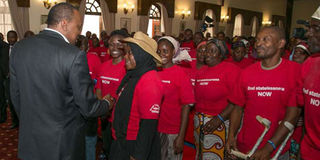Breaking News: At least 10 feared to have drowned in Makueni river
Makonde march to citizenship unstoppable

President Uhuru Kenyatta addressing a delegation of Makonde Community from Kwale County at State House, Nairobi, in 2016.
What you need to know:
- There are 10 million stateless people worldwide and 10,000 of those are in Kwale County.
- Stateless people have to lie low since they face the constant risk of arbitrary arrest or harassment due to lack of identity papers.
- Stateless people are condemned to anonymity and poverty, and that is what the Makonde people who came to the Coast to work on sisal farms 80 years ago have experienced for generations.
On Monday last, I was privileged to attend the flagging off of the Makonde community 550km journey to State House, Nairobi.
The energy, passion and joy around the launch were like the excitement that a newborn brings to a family home. That image sums up the hopes of a stateless community longing for a new life of recognition, dignity, inclusivity and citizenship.
There are 10 million stateless people worldwide and 10,000 of those are in Kwale County. Stateless people are invisible people because they have to lie low since they face the constant risk of arbitrary arrest or harassment because they lack identity papers.
A person can lead a fairly decent life without a family or a residence but a stateless person is a nobody who cannot vote, travel, get a job, open a bank account or even get their children registered in school.
Stateless people are condemned to anonymity and poverty, and that is what the Makonde people who came to the Coast to work on sisal farms 80 years ago have experienced for generations.
Their hike to State House was a last desperate effort to demand citizenship and identity cards. They have had enough and they sought the support of Kenya Human Rights Commission to express their torment.
They are tired of being treated like lepers and their emergence and demand for recognition reminded me of Jesus calling lepers to come forward, be visible, be empowered and be part of the community.
One would have expected that the government would have embraced them, too, but even at the flagging off ceremony, the signs of unease from the police and administration were evident.
Desperate officials kept relaying messages from Coast Regional Coordinator Nelson Marwa to call off the trek and “let’s talk since the Cabinet will discuss the matter at next week’s meeting.” The community were not budging and we flagged off the event.
Mr Marwa was not surrendering and he proceeded to stop the march near Tiwi after failing to persuade the organisers to come and meet him in a village hall.
As usual, he came with the media and lambasted the community for being exploited by NGOs. But community leader Thomas Nguli put the powerful administrator in his place and told him off in front of the cameras.
The march continued to Mombasa but Mr Marwa proceeded to Voi where 300 protesters were detained for two hours at the police station.
Once safely beyond the boundaries of Mr Marwa’s kingdom, the Makonde proceeded peacefully to Nairobi to petition Mr Kenyatta.
However, Mr Marwa’s continuous interference with the protest revealed a man who acts and speaks on behalf of State House in utter disregard of the Constitution. There is one Constitution for Kenya and apparently another for the Coast.
He reminds me of Reuben Rotich, a Kanu activist who, as DC of Turkana, tried to halt civic education, public events and alternative voices. But that was two decades ago. Mr Marwa resembles how a colonial administrator might have ruled when the Makonde first arrived here in 1936.
Kenyans have moved on considerably but this regime has not and this explains its current unpopularity in the coast.
[email protected] @GabrielDolan1





